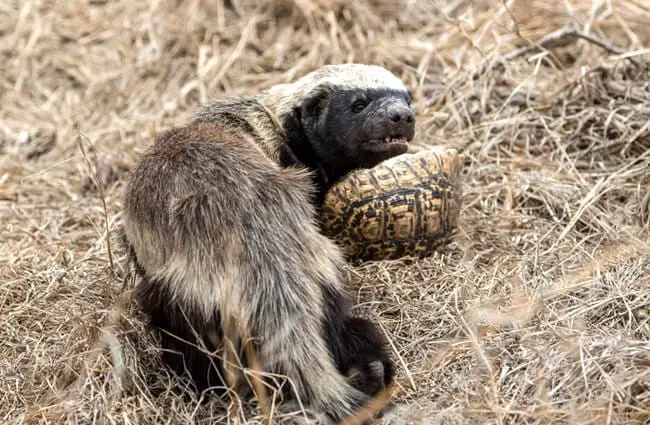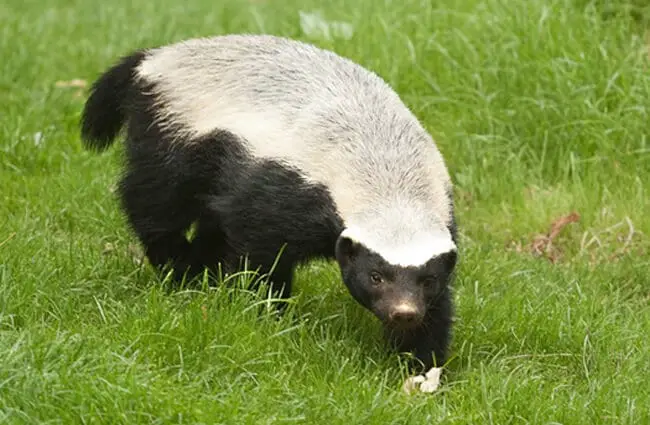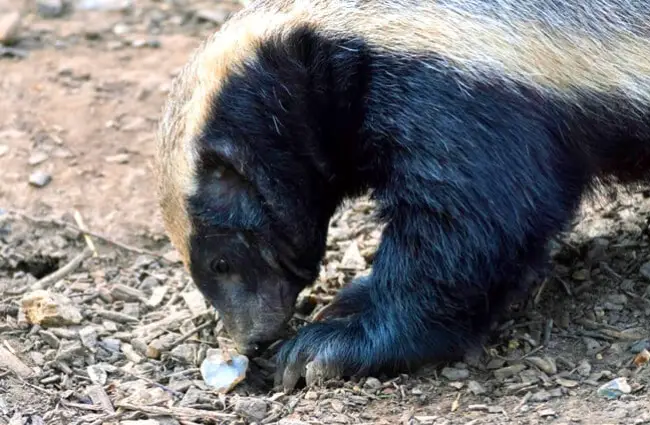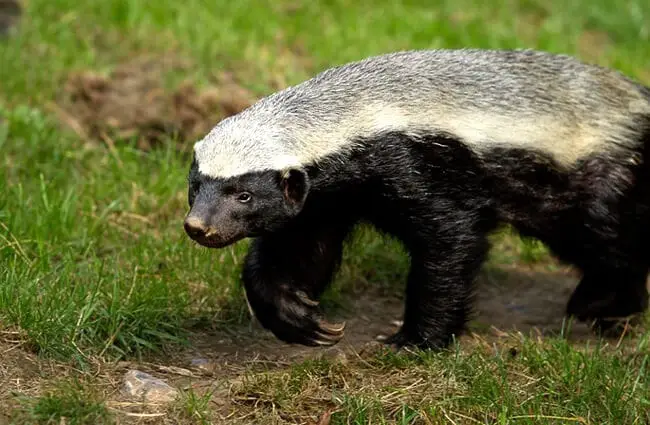Deep within the wild heart of Africa and parts of Asia roams a creature of legendary tenacity and formidable spirit: the Honey Badger. Known scientifically as Mellivora capensis, this member of the weasel family, Mustelidae, is far more than its charming name suggests. Often hailed as the “most fearless animal in the world” by the Guinness Book of World Records, the Honey Badger, or Ratel, is a master of survival, a living testament to evolutionary grit, and a fascinating subject for anyone interested in the natural world.
From its distinctive black and white coat to its relentless pursuit of prey, every aspect of the Honey Badger’s life is a lesson in adaptation and resilience. This comprehensive guide delves into the world of this remarkable animal, offering insights for students, wildlife enthusiasts, aspiring zoologists, and even those who might one day cross paths with one in the wild.
Unveiling the Ratel: Basic Biology and Distribution
The Honey Badger is a medium-sized mustelid, characterized by its robust build, short legs, and a striking coat pattern. Typically, its back, head, and tail are covered in a broad, grizzled white or grey stripe, contrasting sharply with its black underparts, face, and limbs. This unique coloration is thought to serve as a warning to potential predators, a clear signal that this animal is not to be trifled with. Adults usually weigh between 9 to 16 kilograms (20 to 35 pounds) and measure about 60 to 77 centimeters (24 to 30 inches) in length, with a tail adding another 15 to 30 centimeters (6 to 12 inches).
These creatures are largely solitary, preferring to roam their territories alone. While often described as nocturnal, they are more accurately categorized as crepuscular, being most active during dawn and dusk, though they can be seen at any time of day, especially in areas with less human disturbance. Their keen sense of smell is their primary tool for navigating their world and locating food.

Honey Badger’s Habitat: A Versatile Wanderer
One of the most remarkable aspects of the Honey Badger is its incredible adaptability to diverse environments. Its range spans across much of sub-Saharan Africa, the Middle East, and parts of Western and South Asia, including India and Nepal. This wide distribution means they can thrive in an astonishing array of habitats, from dense rainforests and open savannas to arid deserts and mountainous regions.
When seeking a Honey Badger in the wild, one should look for areas offering a combination of cover for shelter and abundant food sources. They are often found in:
- Savannas and Grasslands: Rich in small mammals, reptiles, and insects.
- Arid and Semi-Arid Regions: Their ability to dig extensively allows them to find prey and shelter even in harsh desert conditions.
- Forests and Woodlands: Providing ample cover and diverse food.
- Mountainous Areas: Though less common, they have been observed at high altitudes.
They are not particularly tied to water sources, obtaining much of their moisture from their diet. Their presence is often indicated by their distinctive tracks, which show five toes with long claws on the front feet and shorter claws on the hind feet, or by their extensive burrows, which they either dig themselves or appropriate from other animals.

The Ultimate Omnivore: Honey Badger’s Diet and Hunting Prowess
The Honey Badger’s diet is as diverse as its habitat, cementing its reputation as a true omnivore. While its name suggests a sweet tooth, honey and bee larvae are just a small, albeit famous, part of its extensive menu. These animals are opportunistic hunters and scavengers, consuming almost anything they can overpower or unearth.
Their diet primarily consists of:
- Small Mammals: Rodents, hares, ground squirrels, and even young antelopes.
- Reptiles: Snakes (including highly venomous species like cobras and puff adders), lizards, and tortoises. They are known for their ability to crack open tortoise shells with their powerful jaws.
- Birds and Eggs: Ground-nesting birds and their clutches are easy targets.
- Insects and Larvae: Scorpions, beetles, and, of course, bee larvae and honey.
- Amphibians: Frogs and toads.
- Plant Matter: Fruits, berries, roots, and tubers, especially when other food sources are scarce.
- Carrion: They will readily scavenge on carcasses left by larger predators.
Their hunting strategy is characterized by relentless pursuit and powerful digging. With their incredibly strong claws, they can excavate burrows with astonishing speed, unearthing rodents, reptiles, and insects. They are also known to chase down prey, demonstrating surprising agility despite their stocky build. Their legendary fearlessness allows them to confront and kill prey much larger than themselves, including venomous snakes, which they often dispatch by biting them behind the head.

Evolutionary History: A Lineage of Resilience
The Honey Badger belongs to the subfamily Mellivorinae within the Mustelidae family, making it a close relative of weasels, ferrets, and otters. However, it is the sole surviving species in its genus, Mellivora, suggesting a unique evolutionary path. Fossil records indicate that its ancestors emerged in Africa during the Pliocene epoch, around 5 million years ago.
Over millennia, the Honey Badger has evolved a suite of specialized adaptations that have allowed it to thrive in challenging environments:
- Thick, Loose Skin: Its skin is remarkably thick, up to 6 millimeters (0.24 inches) in some areas, and incredibly loose. This allows the badger to twist and turn within its own skin, even when gripped by a predator, making it difficult to hold onto. It also provides a significant defense against stings, bites, and even machete blows.
- Powerful Claws and Teeth: Its foreclaws are long, strong, and non-retractable, perfect for digging and tearing. Its teeth are robust, designed for crushing bones and tough hides.
- Anal Glands: Like many mustelids, Honey Badgers possess anal glands that produce a potent, suffocating musk. This can be deployed as a defensive weapon to deter predators or mark territory.
- Venom Resistance: Perhaps one of its most famous adaptations is its partial immunity to snake venom. While not completely immune, they can withstand bites from highly venomous snakes that would be lethal to most other animals. After a bite, a badger might appear stunned or even comatose for a short period, only to recover and continue its activities. The exact mechanism of this resistance is still a subject of scientific study, but it is believed to involve specialized proteins in their blood.
- High Intelligence: Honey Badgers are remarkably intelligent and resourceful. They are known to use tools, such as rolling logs to reach food, and have demonstrated impressive problem-solving abilities, including escaping complex enclosures.
These adaptations collectively paint a picture of an animal honed by natural selection to be an apex survivor in its niche, capable of confronting dangers that most other creatures would flee from.

Mating and Reproduction: A Solitary Affair
Honey Badgers are largely solitary animals, and their reproductive habits reflect this independence. Mating encounters are typically brief, with males and females coming together only for the purpose of reproduction before parting ways. There is no long-term pair bonding or extensive parental care from the male.
- Gestation: The gestation period for a Honey Badger is relatively long, lasting approximately 6 to 8 weeks (around 50 to 70 days).
- Litter Size: Females typically give birth to one or two cubs, rarely three, in a secluded den. These dens are often self-dug burrows, but they may also utilize abandoned burrows of other animals or natural crevices.
- Cub Development: Newborn cubs are altricial, meaning they are born blind, hairless, and completely dependent on their mother. They remain in the den for several weeks, suckling milk and growing rapidly.
- Parental Care: The mother is solely responsible for raising her young. She will fiercely protect her cubs, moving them between dens if she perceives a threat. Cubs are weaned around 6 to 8 months of age but may stay with their mother for over a year, learning essential survival skills such as hunting, digging, and avoiding danger. This extended period of maternal care is crucial for the cubs’ development into independent and formidable adults.
- Sexual Maturity: Honey Badgers reach sexual maturity around 1 to 2 years of age, at which point they disperse to establish their own territories.

Ecosystem Contribution and Interactions with Other Animals
Despite its relatively small size, the Honey Badger plays a significant role in its various ecosystems. As a highly effective predator and scavenger, it helps to regulate populations of small mammals and reptiles, contributing to the overall health and balance of its environment.
- Pest Control: By preying on rodents and insects, Honey Badgers act as natural pest controllers, which can be beneficial in agricultural areas, though their taste for poultry can sometimes put them at odds with farmers.
- Soil Aeration: Their extensive digging activities, whether for prey or shelter, contribute to soil aeration and nutrient cycling, benefiting plant growth.
- Competition: Honey Badgers compete with other mesopredators like jackals, civets, and even larger carnivores like leopards and hyenas for food resources. While they generally avoid direct confrontation with larger predators, their fearlessness means they will often stand their ground or even attempt to steal kills.
- Predator-Prey Dynamics: Their ability to hunt venomous snakes makes them a unique component of the food web, influencing snake populations.
- Commensalism with Honeyguides: The popular notion of Honey Badgers collaborating with Honeyguide birds is largely anecdotal and romanticized. While Honeyguides do lead animals to beehives, it is more likely that humans or other animals follow the birds, rather than a consistent, mutualistic relationship with the Honey Badger. Honey Badgers are perfectly capable of finding beehives on their own.
Honey Badgers and Humans: Conflict, Culture, and Conservation
The Honey Badger’s interactions with humans are complex, often marked by conflict due to their opportunistic nature, but also by a grudging respect for their tenacity.
Interaction with Humans: A Double-Edged Sword
While generally shy of humans, Honey Badgers can become a nuisance or even a danger when their territories overlap with human settlements or agricultural activities.
- Livestock Predation: They are known to raid chicken coops and prey on small livestock, leading to retaliatory killings by farmers.
- Beehive Raids: Their love for honey and bee larvae makes them a significant threat to beekeepers, who often suffer considerable losses.
- Defensive Behavior: When cornered or threatened, a Honey Badger will defend itself ferociously. They are capable of inflicting serious bites and scratches, and their powerful jaws and sharp claws can cause significant injury.
Encountering a Honey Badger in the Wild: What to Do
For hikers, wildlife enthusiasts, or anyone venturing into Honey Badger territory, an encounter can be an exhilarating but potentially risky experience. Here’s what to do:
- Maintain Distance: The most important rule is to give the animal plenty of space. Do not approach it, especially if it has young or is feeding.
- Do Not Provoke: Never try to corner, harass, or feed a Honey Badger. This can lead to an aggressive defensive reaction.
- Make Yourself Known: If you accidentally surprise one, speak in a calm, low voice to let it know you are human and not a threat.
- Back Away Slowly: If the badger shows signs of aggression (hissing, growling, charging), back away slowly and calmly. Do not run, as this might trigger a chase response.
- Do Not Turn Your Back: Keep facing the animal as you retreat.
- Seek Shelter (if necessary): If the badger continues to advance aggressively, seek refuge in a vehicle or climb a sturdy tree, if possible.
Remember, Honey Badgers are wild animals and should be treated with respect and caution. Their fearlessness is legendary, and they will not hesitate to defend themselves.
Contribution to Human Culture
The Honey Badger’s indomitable spirit has earned it a place in human culture, particularly in areas where it coexists with people. It is often seen as a symbol of courage, tenacity, and resilience. Its reputation for fearlessness has led to its adoption as a mascot or emblem for various organizations, including military units, symbolizing an unwavering refusal to back down.
In popular culture, the Honey Badger gained significant internet fame through viral videos highlighting its audacious behavior, further cementing its image as a tough and unstoppable force of nature.
Caring for a Honey Badger in Captivity: A Zookeeper’s Guide
Caring for a Honey Badger in a zoological setting requires specialized knowledge and a deep understanding of its natural behaviors and needs. These are not easy animals to manage, given their intelligence, strength, and defensive capabilities.
- Enclosure Design:
- Security: Enclosures must be escape-proof, featuring strong, high walls (at least 3-4 meters or 10-13 feet) with overhangs to prevent climbing. Buried mesh or concrete foundations are essential to prevent digging out.
- Space: Ample space is crucial for these active animals, allowing them to express natural behaviors like digging, foraging, and exploring.
- Substrate: A deep substrate of sand and soil is vital to allow for extensive digging, which is a primary enrichment activity.
- Shelter: Provide multiple sturdy dens or burrows for resting and security.
- Water: A clean water source for drinking and a shallow pool for bathing should be available.
- Diet in Captivity:
- A varied diet mimicking their natural omnivorous intake is essential. This includes high-quality carnivorous animal feed, a variety of whole prey items (e.g., mice, rats, chicks), insects (crickets, mealworms), eggs, and a selection of fruits and vegetables.
- Honey and bee larvae can be offered as occasional treats or enrichment.
- Diet should be carefully balanced to prevent obesity and nutritional deficiencies.
- Enrichment:
- Honey Badgers are highly intelligent and prone to boredom, requiring constant mental and physical stimulation.
- Foraging Opportunities: Hide food items throughout the enclosure, use puzzle feeders, or scatter food to encourage natural foraging behaviors.
- Digging: Provide logs, rocks, and other items they can manipulate and dig around.
- Novelty: Regularly introduce new scents, objects, or changes to the enclosure layout to keep them engaged.
- Training: Positive reinforcement training can be used for husbandry behaviors, such as shifting between enclosures or presenting for veterinary checks, which also provides mental stimulation.
- Social Structure: As solitary animals, Honey Badgers are typically housed individually, except during controlled breeding periods.
- Veterinary Care: Regular health checks are vital. Due to their defensive nature, these often require chemical immobilization. Keepers must be trained in safe handling procedures and emergency protocols.
- Avoid:
- Underestimating their strength and intelligence: They are master escape artists.
- Direct physical contact: Unless absolutely necessary and under strict veterinary supervision, direct handling should be avoided due to the risk of severe injury.
- Monotonous environments: Lack of enrichment leads to stereotypic behaviors and poor welfare.
- Inadequate security: This poses a risk to both the animal and staff/public.
A Huge List of Interesting Facts About Honey Badgers
To truly appreciate the Honey Badger, one must marvel at its extraordinary collection of traits and behaviors:
- Guinness World Record Holder: Officially recognized as the “most fearless animal in the world.”
- Master Diggers: Can dig a burrow in hard ground in mere minutes, disappearing from sight with astonishing speed.
- Tool Users: Have been observed using tools, such as rolling logs to reach food or using rocks to smash eggs.
- Venomous Snake Hunters: Regularly prey on highly venomous snakes, including cobras and mambas, often surviving bites that would be fatal to other animals.
- Thick Skin: Their skin is so thick and loose that it’s incredibly difficult for predators to get a firm grip, and it protects them from stings and bites.
- Powerful Jaws: Possess incredibly strong jaws and teeth capable of crushing bones and tortoise shells.
- Stinky Defense: Can emit a powerful, foul-smelling musk from their anal glands to deter predators, similar to a skunk.
- Highly Intelligent: Known for their problem-solving abilities and cunning, often outsmarting human attempts to contain them.
- Nocturnal and Crepuscular: Primarily active at dawn, dusk, and night, but will forage during the day if undisturbed.
- Solitary Lifestyle: Generally prefer to live and hunt alone, only coming together for mating.
- Wide Distribution: Found across a vast geographical range, from Africa to parts of Asia.
- Omnivorous Diet: Eat almost anything, from insects and reptiles to small mammals, birds, roots, and fruits.
- Long Lifespan: Can live up to 26 years in captivity, though typically shorter in the wild.
- Aggressive Reputation: Will stand their ground against much larger predators like lions and hyenas, often driving them away.
- Excellent Climbers: Despite their stocky build, they are surprisingly agile climbers and can scale trees and fences.
Conclusion: The Unyielding Spirit of the Ratel
The Honey Badger, or Ratel, is a creature that defies expectations and embodies the raw, untamed spirit of the wild. From its remarkable adaptations for survival in diverse habitats to its legendary fearlessness and intelligence, every aspect of its biology and behavior tells a story of evolutionary success. While its interactions with humans can sometimes be challenging, the Honey Badger’s contribution to its ecosystem and its symbolic power in human culture are undeniable.
Understanding and appreciating this formidable mustelid is not just about learning facts; it is about recognizing the incredible diversity and resilience of life on Earth. As we continue to explore and learn about creatures like the Honey Badger, we gain a deeper respect for the intricate web of nature and our place within it. The Honey Badger reminds us that even the smallest among us can possess the greatest courage, a true marvel of the animal kingdom.

![Red Angus Closeup of a beautiful Red Angus cowPhoto by: U.S. Department of Agriculture [pubic domain]https://creativecommons.org/licenses/by/2.0/](https://animals.net/wp-content/uploads/2020/03/Red-Angus-4-238x178.jpg)




![Red Angus Closeup of a beautiful Red Angus cowPhoto by: U.S. Department of Agriculture [pubic domain]https://creativecommons.org/licenses/by/2.0/](https://animals.net/wp-content/uploads/2020/03/Red-Angus-4-100x75.jpg)

